Epstein's Arrest Shook The Blockchain
Jeffrey Epstein's death in 2019 seems to have set off a wave of suspicious crypto payments that have heretofore gone unexamined.
This is a continuation of a previous post on the surprisingly large number of characters in Epstein’s network who are deeply involved in the cryptocurrency space, “Epstein’s Cryptic Touch”.
"There is nothing in the world that is not mysterious, but the mystery is more evident in certain things than in others."
- Jorge Luis BorgesI have a confession to make. When I chose to write my recent overview of the individuals in Jeffrey Epstein’s network who were (and in most cases still are) involved in various crypto grifts, there might have been a little bit of the lure of clickbait involved in my decision making process. Epstein is, after all, a pretty hot topic right now. And sure, I figured a post summarizing what is currently known about Epstein’s connections to the rolling tsunami of fraud and cringe that is today’s cryptocurrency industry could contribute some possibly important information to America’s current political conversation. But maybe more importantly I knew that a post with his name in the title would be tantalizing clickbait.
But I wasn’t aware of any reason to think Epstein was himself a crypto bro. Which is not to say there weren’t reasons to suspect that he might be - there definitely were. But the overall picture was a lot more “guilt by association” and not so much “guilty beyond a reasonable doubt”. Epstein’s vast and partially unexplained wealth could have come from crypto, but it also could have come from just being good at helping rich people avoid taxes. He liked to hang out in places where crypto grifts run free like the wind (Dubai, Russia, Israel, etc.) but then again so does every other kind of hyperwealthy scumbag. And yes, the number of bros in his inner circle was indeed eyebrow raising, but at the same time it isn’t exactly shocking that the kind of people who would want to be friends with Jeffrey Epstein would include a lot of crypto grifters. Crypto is primarily a tool for amoral financial elites to move vast quantities of other people’s money into their own pockets and being friends with most of the world’s amoral financial elites was kind of Jeffrey Epstein’s whole deal.
However as I was in the final stages of editing and fact checking (which, like all good Substackoors, I do immediately after I hit publish… sorry, I’m working on it) I stumbled on the details1 of some communications between Epstein and a “former”2 member of Russia’s FSB3 that stopped me dead in my tracks.
Apparently Mikhail Khodorkovsky’s Dossier Center had obtained copies of a conversation in which Epstein had proposed the creation of a BRICS4 cryptocurrency as a means by which Russians could evade the international sanctions imposed in the aftermath of Putin’s first and far more successful Ukrainian adventure5.
Devoted readers of The Cryptocalypse Chronicles will have heard me describe the ideal user base for cryptocurrency as “a cabal of organized crime groups, kleptocratic regimes, and rogue nuclear states”6. That’s because criminals, kleptocrats, and rogue nuclear states are all dealing with the one problem crypto can actually solve that traditional finance cannot: they want to move money around the world and they don’t want anyone to be able to stop them. And now I was reading that Jeffrey Epstein had pitched cryptocurrency to exactly that user base as a way to solve exactly that problem more than ten years ago.
Epstein’s understanding of cryptocurrency, it turned out, was far more sophisticated than I had assumed. Not only did he have a clear grasp of crypto’s core use case, he had even proposed a relatively sophisticated blockchain based solution to Russia’s thorny sanctions problems. All of this made me suspect that Epstein might have been far more involved in the crypto economy than anyone has yet proven.
[ed. note] Since publishing this post it has come to my attention that Epstein actually gave a fully blown interview about bitcoin and crypto to someone who fancies herself a journalist back in 2017. The resulting article contains very little actionable information and is generally an embarrassment to the entire idea of journalism but it provides extremely strong reinforcement for the case I’m making in this post: Epstein’s involvement in the crypto industry goes far beyond what has yet been uncovered.
Which got me thinking: if Epstein actually had been a big player in the cryptoverse then perhaps there might be some detectable perturbations in the blockchain data around the time of his downfall. Maybe Epstein stashed a huge pile of crypto somewhere beyond the reach of American law enforcement when the walls started closing in. Or maybe he had been a major crypto trader whose purchases were moving the crypto markets - there were a whole host of possible scenarios I could envision. Thankfully most of them were relatively easy to prove and/or disprove just by poking around the data stored in various blockchains.
So I did some poking around and, lo and behold, it turned out that a lot of Very Weird Shit was going on “on chain” at exactly the time Epstein was busy shuffling off this mortal coil. And while Very Weird Shit in semi-anonymous data can’t really prove anything without other forms of corroborating evidence, it seemed pretty clear to me that what I was looking at was extremely unlikely to be mere coincidence.
THE BITCOIN
Epstein was arrested on July 6th, 2019 as he stepped out onto the tarmac at New Jersey’s Teterboro Airport at the end of a private jet flight from France. He ended his own life7 in a New York City jail cell roughly a month later. A few days afterwards, in what I’m sure is Totally Just A Coincidence, more bitcoins moved “on chain” than all but one other day in modern bitcoin history8.
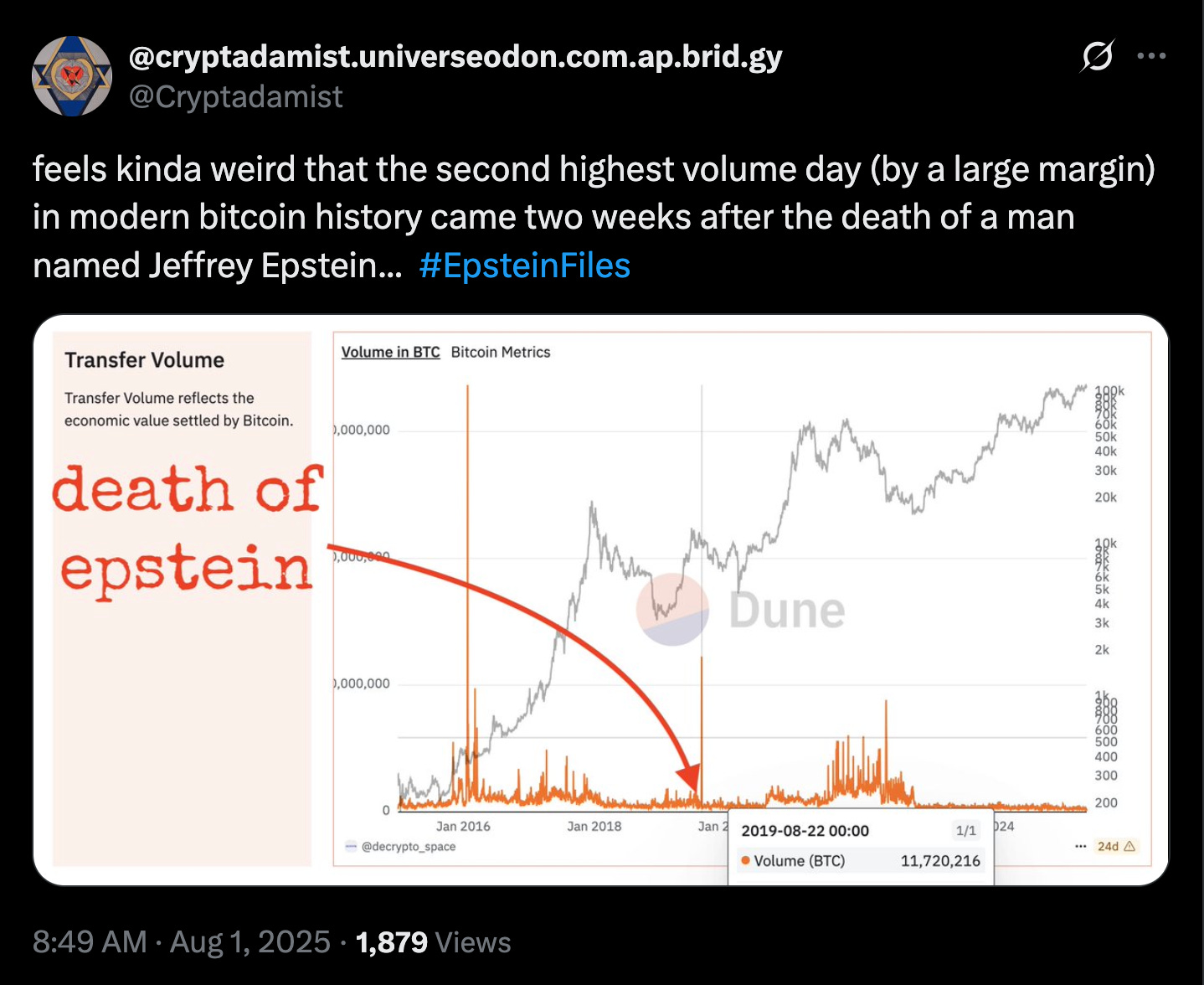
There are certain quirks in how bitcoin transactions work that mean that a single wallet with a lot of bitcoins can, by sending a bunch of small transactions, create what at first glance looks like a lot of interparty transfer activity when it’s really just one guy choosing to structure his transactions in a particular way. Without getting too deep in the weeds I’ll just say that it looks like that’s what happened here. A single “whale”9 transferred batches of bitcoins to a large number of new wallets and the “change”10 from those transfers created an extraordinary quarter trillion dollars worth of bitcoin transactions in a single day.
This explosion of activity did not go unnoticed at the time it happened but it did go unexplained, even if one person chimed in with the possibility that someone had just used their massive pile of bitcoins to buy an absurd amount of CBD oil11.
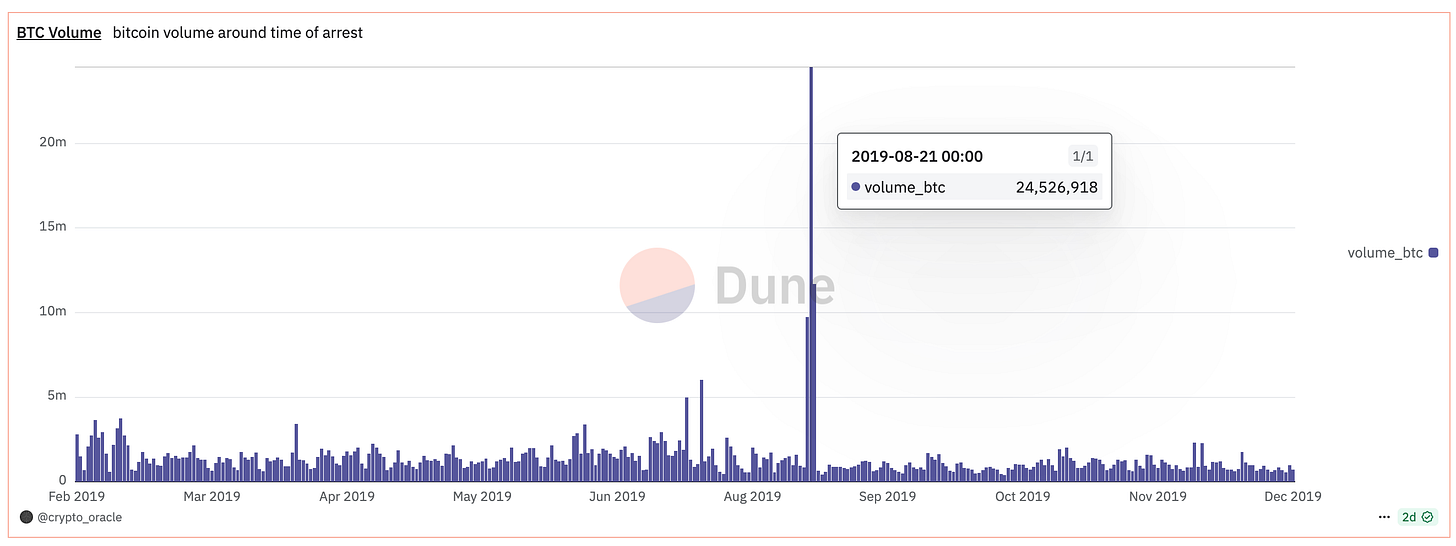
So who was this whale that needed to move a quarter trillion dollars of bitcoins a few days after Epstein killed himself12? The mystery only deepened when I discovered that the wallet causing the massive spike in transaction volume happened to be one of a large number of bitcoin addresses someone had grouped together and publicly identified as belonging to an organization named “InvestmentDouble”.

The vast majority of bitcoin wallet addresses are anonymous13, by which I just mean no one has yet publicly identified who controls them. It’s kind of inherently curious that someone bothered to label this wallet at all, much less group it with so many other wallets and label them all with such a dubious name. And while I haven’t been able to dig up any additional information about who or what controlled this group of “InvestmentDouble” wallets there are a few observations we can make about them from the data.
The last outbound bitcoin transaction from this group of wallets happened on December 23rd, 2019. Around $700,000 worth of bitcoins (at today’s prices) has sat untouched ever since.
Very small inbound transactions continued to trickle in until two years ago. Sometimes when you see these kinds of small transactions during a long period of inactivity they are interest payments or fees earned from other activities taken by the wallet owner, but I’m not sure that’s what’s happening here.
More than 50% of InvestmentDouble’s most recent outbound transactions went to HTX, a Chinese crypto exchange that in the time since has come under the control of Tether collaborator Justin Sun. More recently Justin Sun became the business partner of Donald Trump after “investing” over $200 million in Trump family crypto businesses, after which the SEC’s fraud charges against him were dropped.
If you follow the trail of the wallets that received the largest transfers from this wallet, you find a series of 5-10 intermediate wallets before most of the funds end up… back in this wallet. That’s a pretty good indicator of money laundering activity.
I will also note that “InvestmentDouble” is exactly the kind of name you’d expect to see attached to a crypto fraud. Bots pitching “send us a bitcoin and Elon Musk will send you two bitcoins back” style scams are so common on The Privatized Public Square14 that it’s almost difficult to imagine a public discussion of cryptocurrency taking place without their incessant attempts to chime in in the replies. But in particular, to me, speaking extremely subjectively, it also has the ring of the names of various binary options frauds that were run by Russian organized crime groups operating out of Israel.
So maybe “InvestmentDouble” was just a massive investment fraud and/or ponzi scheme that was totally unrelated to Jeffrey Epstein or any of his friends in Russian or Israeli intelligence. But I will at least mention that I know of at least one case where funds raised from a billion dollar crypto ponzi scheme were linked to the funding of Russian paramilitary groups operating in Africa and Ukraine15. I find myself wondering if something along those lines could be the explanation for what happened here. Perhaps these were Epstein’s coins and after he was deceased they were disbursed to his business partners. Or maybe the intelligence agency of some sanctioned country was seeking to disguise its on chain movements behind some quasi-legitimate gambling operation (casinos are an incredibly effective tool for laundering money of all kinds). Maybe Epstein himself was the operator of that quasi-legitimate gambling operation.
There’s a million plausible scenarios and unfortunately so far precious little actual evidence.
THE STABLECOIN
Bitcoin wasn’t the only cryptocurrency with interesting synchronicities to the Epstein timeline. In fact the disruptions to the stablecoins markets were, in my opinion, far more obviously correlated with Epstein’s downfall.
(Ed. note: if you don’t know what a stablecoin is just think of it like an American bank, except for criminals. Sending stablecoins from one account to another is just like sending dollars from one of the accounts at the bank to another one. Read my piece on Tether for a more fulsome explanation.)
In my previous piece on Epstein’s crypto connections I discussed Epstein’s relationship with Brock Pierce, the self appointed “hippie king of crypto” whose resumé includes co-founding Hollywood’s most infamous fully confirmed paedophile ring, launching several businesses with Steve Bannon, and donating large amounts of money to corrupt New York City mayor Eric Adams (I had a lot to say about that last relationship). Pierce also served as the “doulah for creation”16 of the world’s first and now far and away largest money laundering machine dollar backed stablecoin, Tether.
Tether, whose hundreds of billions of dollars are/were managed by Jeffrey Epstein’s former next door neighbor and America’s current Secretary of Commerce Howard Lutnick, was the subject of a long post on this blog that you can and should read if any of this information is new to you.
Until I stumbled on Epstein’s conversation with the “former” FSB operative about the creation of a BRICS cryptocurrency the only hint of a possible relationship between Epstein and stablecoins that I was aware of was the fact that Epstein had invited Brock Pierce to give a speech about cryptocurrency at the “Mindshift” conference17 on Little Saint James Island a few years before Pierce and friends created what would go on to become both the central bank of crypto as well as the largest financial services firm in human history to have never been audited.
Now there are a lot of good reasons to suspect Jeffrey Epstein might have been involved in moving money for some of the world’s more distasteful people, chief among them the fact that his first job after leaving traditional finance in the 1980s was laundering money creating offshore financial vehicles and shell companies for Adnan Khashoggi, possibly the most infamous international arms trafficker of the post-war era. If Epstein had still been engaged in that line of work when he was arrested, then perhaps his abrupt departure could have created ripple effects in the wider world of international money laundering. Perhaps those ripple effects might have shown up as a sudden and dramatic increase in the amount of money being moved around “on chain”.
Which is… exactly what the data shows.
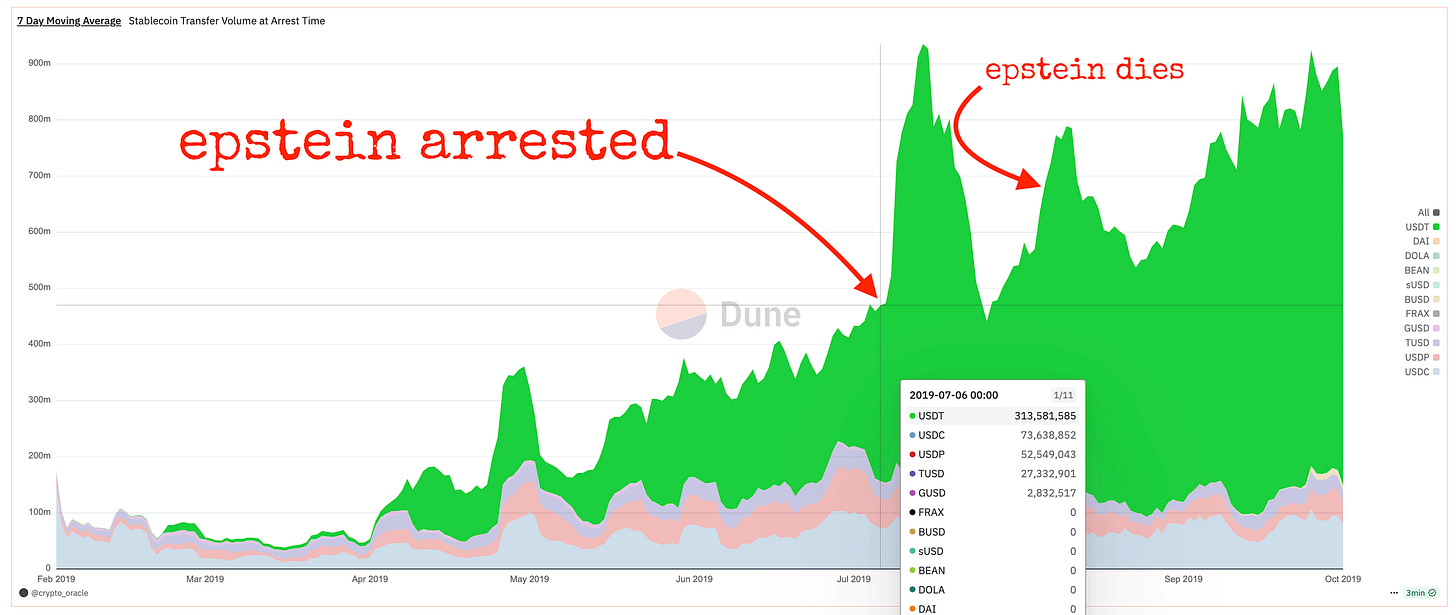
Starting less than 48 hours after Epstein’s arrest stablecoin transfer volumes almost doubled. This was followed by a quick dip during the weeks Epstein spent locked in a jail cell and another big spike that peaked a few days after his death. And of course who could fail to notice that pretty much the entirety of the increased volume came from Tether, the stablecoin whose bank accounts went on to be managed by Jeffrey Epstein’s next door neighbor Howard Lutnick.
I’m sure that’s just a coincidence.
Anyways as far as what the data actually means, it is, of course, impossible to know for sure. It could have nothing to do with Epstein (though IMHO that’s pretty unlikely). But here’s a possible scenario that could explain what we’re looking at.
If it were the case that:
Epstein’s arrest unexpectedly deprived the world’s criminals and rogue nation states of a major money launderer and…
That money launderer’s customers suddenly found themselves in need of a new provider of money laundering services and…
The provider they chose was Tether…
Then this is pretty much exactly what I would expect the chart to look like. Note that this scenario is agnostic as to whether Epstein was himself using stablecoins to move money around prior to his arrest. All we know for sure is that someone, somewhere, for whatever reason, felt a need to start moving around twice as much money “on chain” had ever been moved before more or less immediately after the FBI placed handcuffs on Jefrey Epstein’s wrists.
It’s also worth pointing out that stablecoin volumes never really went back down to the level they had been at before Epstein was arrested. Epstein’s arrest came at the exact moment stablecoin volumes more or less permanently doubled.
All of this is what the kids call “sus”.
THE MAXWELL FAMILY, REVISITED
When I wrote the section in my last post about Isabel Maxwell, Brock Pierce, and Epstein’s convergence at the “Mindshift” conference Epstein organized on Little Saint James Island there were a few facts that I forgot to mention that I’d like to highlight here. For instance I forgot to include the fact that a mutual friend of Isabel Maxwell and Brock Pierce managed to fall out of a 25th floor window in Singapore back in 2014.

Only a few newspapers reported Autumn Radtke’s death as a possible suicide. Most chose to describe her demise as “mysterious” or “unexplained.” For what it’s worth I will say that people I’ve spoken to who were active in the Asian crypto industry around that time are pretty fixated on the idea that Autumn Radtke Didn’t Kill Herself. Personally I don’t have a well formulated opinion on the matter; I just wanted to point out that it’s kind of… odd, let’s say, that an apparently close friend and business associate of two of the people in Epstein’s crypto orbit fell out of a window.
This of course wouldn’t be particularly suspicious if Autumn Radtke were the only person in Epstein’s extended crypto circle to fall out of a 25th floor window. Which, thankfully, she was, because Al Seckel - Isabel Maxwell’s husband18, Ghislaine Maxwell’s brother-in-law, and the man who delivered Epstein’s “Mindshift” invitation to Brock Pierce - didn’t fall out of a window.
He fell off a cliff.
POST SCRIPT AND MUSICAL CODA
I’m going to post a few more charts for the data nerds in the audience. I have considerably less confidence that these charts really prove much of anything, but they’re also at least pretty interesting.
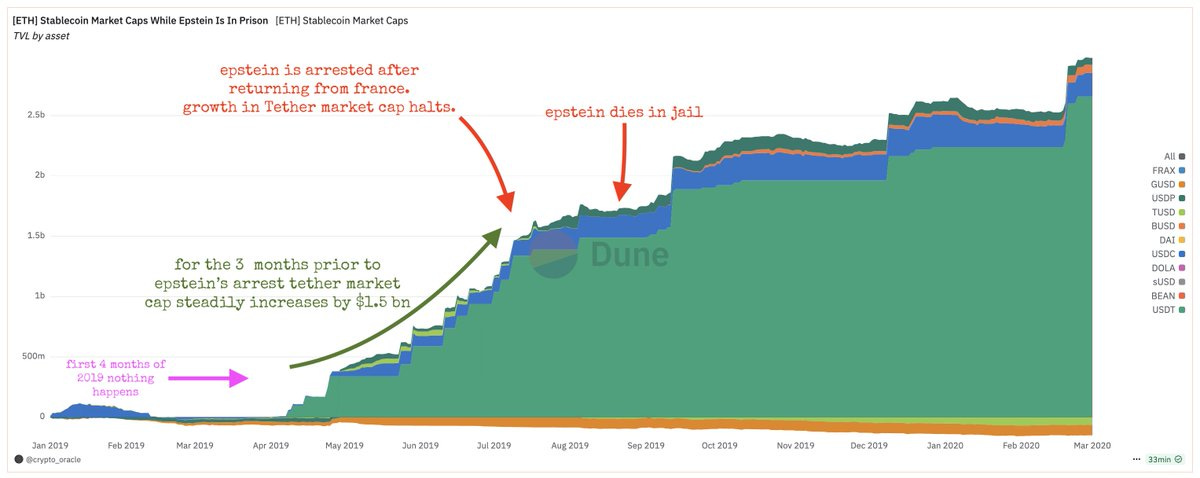
Unlike the other charts which show daily stablecoin transfer volume, this chart shows the change in the total number of stablecoins in existence over the course of the months immediately preceding and following Epstein’s arrest. In my opinion it’s far less obviously correlated with events in the Epstein timeline but I’m sharing it because it still feels like it might be hinting at something.
I’ll note that April 4th, 2019 - visible in the chart as “the day Tether’s market cap started to take off like a rocket” - was the same day Tether announced its partnership with Justin Sun. That, in turn, is an important demarcation date in Tether’s evolution from a primarily Russian money laundering operation to its current incarnation as a primarily Chinese money laundering operation. I’ve never seen any evidence whatsoever of Epstein working with any kind of Chinese organized crime but one mystery that has long plagued me is this: why would Russian organized crime ever let an incredibly profitable and relatively risk free business like Tether fall into the hands of the Chinese?
One possibility I’ve considered is that Epstein was the Russians’ gateway to the western financial system and without his services Tether was far less useful to them. But that’s just wild speculation without much evidence, which is why it’s down here in the post script section.

This is another chart that piqued my interest. Maybe most interestingly the day of Epstein’s death saw one of the largest issuances of new Tether USDT tokens in 2019. Also notable is the day in between Epstein’s arrest and death where someone redeemed tens of millions of dollars worth of each of Tether’s major competitors: Circle USDC, Paxos USDP, and TrueUSD TUSD. TrueUSD has an important relationship with by Tether’s Justin Sun. While I have no real reason to believe these issuances and redemptions were related to Epstein, they do at least stand out as potential events of interest.
(If anyone is interested in the raw data behind some of these charts, leave a comment and I’ll get it to you.)
And finally, here’s another fun thing to think about: everyone assumes that Trump is covering up the Epstein files because those files reveal him to be some kind of pedophile. But what if the files instead reveal that Trump and Epstein were working together to launder Russian money? It’s hardly a secret that Trump’s real estate projects from the 1980s to early 2000s wre rife with Russian oligarch money - oligarchs buying apartments in Trump Tower, oligarchs lending the Trump Organization money to build hotels, and so on. Senator Ron Wyden has recently been talking about Epstein’s bank transfers, many of which involved Russian banks. If Epstein and Trump were friends who liked doing real estate deals with Russian money, it seems reasonably likely to me that they might have done some deals together.
If you enjoyed reading this post I encourage you to smash those “Like” and “Restack” buttons to help spread the word. You can also use this button to share this post with anyone you know who might find it interesting.
Here’s a little exit music:
Published by Mikhail Khodorkovsky’s Dossier Center.
Pronounced “current”.
Roughly the Russian equivalent of MI6, the CIA, Mossad, etc.
BRICS, for those who don’t know, is an acronym meant to summarize the world’s second tier developing economies - Brazil, Russia, India, China, and South Africa - into one handy and fun to say phoneme. Now that China is the world’s second largest economy it’s kind of worn out its usefulness as geopolical shorthand but people still use it as kind of shorthand for “economically important countries that chafe under the hegemony of the U.S. dollar”.
Crypto bros like to talk about BRICS in the context of “de-dollarization”, meaning the moment when, at some point in the future, the world decides to use something besides the U.S. dollar as the currency it prefers to use to settle trades in things like oil, soybeans, steel, etc. De-dollarization excites the bros because their religion impels them to believe that the only possible alternative to the U.S. dollar is bitcoin and therefore de-dollarization will inevitably send the price of bitcoin “to the moon”. One of their favourite portents of de-dollarization is the rise of a BRICS currency.
This is, of course, ridiculous on a whole lot of levels. For there to be a BRICS currency the leaderships of countries like Russia, India, and China would have to agree to give power over their entire economies not only to each other, but also to pesky democracies like Brazil and South Africa. And for a country like the United States to adopt bitcoin as its preferred reserve asset would mean the government of the United States consenting to a system wherein if North Korea hacks Bitcoin Fort Knox and steals all the bitcoins, well that would mean tough shit for the U.S. economy and glory to the new Croesus, Glorious Leader Kim Jong Un, Master of the Universe. It’s just not happening, folks.
The annexation of Crimea in 2015.
This is the only crowd I’ve ever been able think of that really would absolutely benefit from the very few features blockchains can provide and traaditional data stores cannot, specifically the fact that no centralized entity can step in and stop a blockchain transaction.
Allegedly.
At least, in modern bitcoin history. Some weird stuff happened in the very early days when bitcoins were just a fun game for computer dorks.
Crypto speak for “guy (trust me on the pronoun) who owns a lot of crypto”.
I’m not going to get into the details, but imagine I have $100 worth of bitcoin and I want to send you $1 worth of bitcoin. This can be structured as a single transaction where $1 goes to you and $99 goes to a “change” wallet that I control.
Unfortunately that person couldn’t remember what caused them to the think some of the transactions had anything to do with CBD oil, but I will just point out that the trade in CBD oil is a very “grey” market that is sometimes a front for what is actually black market activity.
Allegedly.
Maybe technically pseudonymous but who’s counting.
FKA “X”, FKA “Twitter”.
The most prominent example of such a group is Wagner Group but they are far from alone.
Don’t worry, I don’t know what that means either.
Interestingly the “Mindshift” conference took place in 2011, several years before Brock and friends launched Tether in 2014. It’s at least possible that Epstein planted the idea of a dollar backed stablecoins in the founders’ minds. Certainly would explain why Tether is by far the largest financial company in the world that has never undergone a standard audit.
Sort of. Seckel was a con man who never divorced his first wife so his marriage to Isabel Maxwell was, like many of the things in the man’s life, fake.







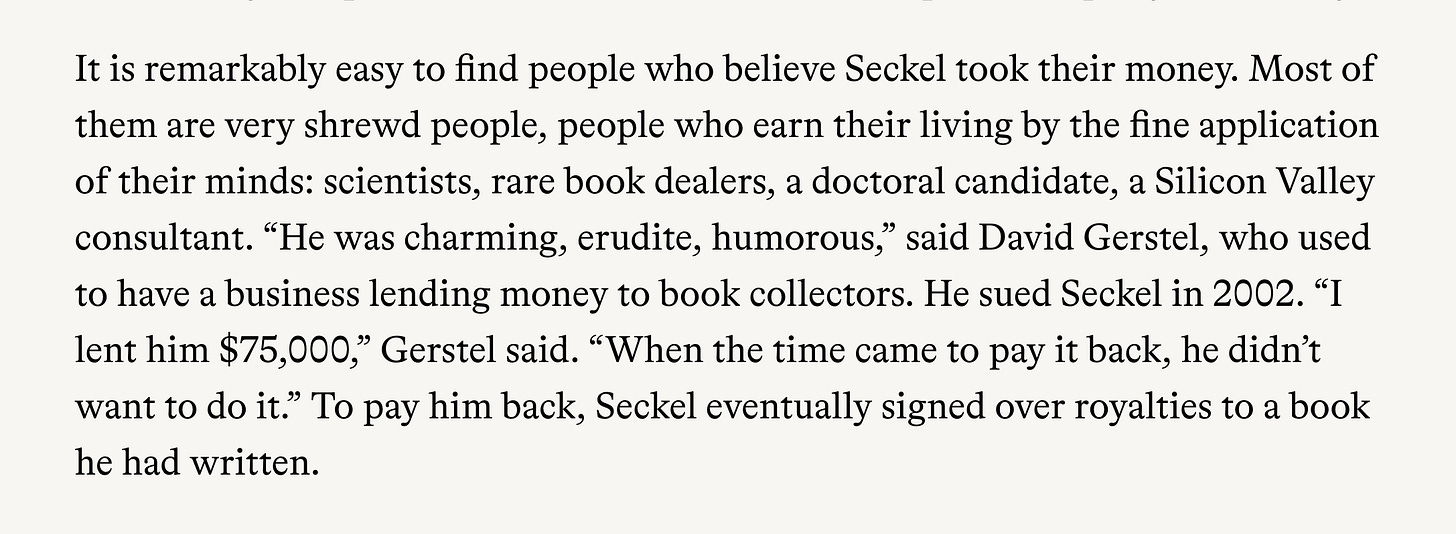

I love a juicy conspiracy story and this hits all the right notes. It’s a more plausible explanation for the Epstein wealth, and influence. The premise that Epstein made his money by blackmailing masters of the universe was always BS. Any one of them would have had him killed way before his supposed suicide. And the claim that rich men were paying him to procur underage women, also falls flat. You don’t become a billionaire by being a pimp. Sex for sale is a major German, and Dutch industry, why bother flying into the Caribbean to a US Island. Yes, a crypto based money laundering or tax evasion service makes the most sense.
I assume somewhere in there would be Epst's good and close neighbor of many years Lutnick and and the BB regime.